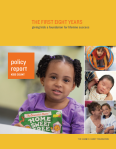The Annie E. Casey Foundation‘s new KIDS COUNT report calls for a comprehensive and integrated system of supports and services for children from birth through age eight and provides new data to help make the case. The report, The First Eight Years: Giving Kids a Foundation for Lifetime Success, reviews the research evidence about the importance of early childhood investments, and documents disparities in young children’s development and access to services by income and race/ethnicity. The comprehensive, integrated services called for in the report include parent education and income supports, improved access to quality early care and education, health care, and developmental screenings.
calls for a comprehensive and integrated system of supports and services for children from birth through age eight and provides new data to help make the case. The report, The First Eight Years: Giving Kids a Foundation for Lifetime Success, reviews the research evidence about the importance of early childhood investments, and documents disparities in young children’s development and access to services by income and race/ethnicity. The comprehensive, integrated services called for in the report include parent education and income supports, improved access to quality early care and education, health care, and developmental screenings.
The report features new analysis of nationally representative data from the Early Childhood Longitudinal Study – Kindergarten Class of 1998-99, focusing on third-grade results. Especially valuable are the data breakouts by income and by race and hispanic origin.
Here are a few compelling findings from the report:
- Only 36 percent of third graders nationally were on track in cognitive knowledge and skills. This means that children scored at or above the national average on math, reading, and science assessments.
- An analysis
 by income level shows economic disparities, with only 19 percent of third graders in low-income families being on track in cognitive knowledge and skills, compared with 50 percent of third graders in higher-income families. (Low-income was defined as families with incomes below 200 percent of the federal poverty threshold.)
by income level shows economic disparities, with only 19 percent of third graders in low-income families being on track in cognitive knowledge and skills, compared with 50 percent of third graders in higher-income families. (Low-income was defined as families with incomes below 200 percent of the federal poverty threshold.) - Just 56 percent of third graders nationally were on track in terms of their physical well-being, which included healthy weight and very good overall health.
For a full overview, check out the Foundation’s press release, which provides key findings and policy recommendations.




